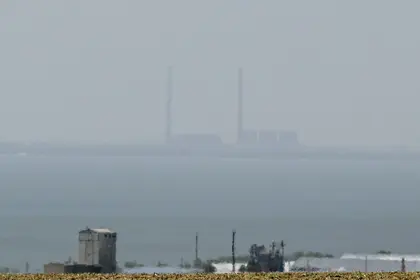“Today, for the first time in history, the Zaporizhzhia nuclear power plant stopped. The emergency protection of the power units worked – after the last working line of the plant’s power return to the Ukrainian power system was damaged by Russian shelling.” President Volodymyr Zelensky announced Aug. 25.
The president emphasized that only the immediate activation of diesel generators as a backup power supply and the quick reaction of the plant staff after the blackout saved Ukraine and Europe from a radiation accident.
JOIN US ON TELEGRAM
Follow our coverage of the war on the @Kyivpost_official.
The disconnection occurred due to fires at the Zaporizhzhia thermal power station (TPP) ash pits, located next to the Zaporizhzhia NPP, reported Energoatom, the Ukrainian state enterprise operating all four nuclear power stations.
“As a result, two working power units of the station were disconnected from the network. Thus, the actions of the Russian invaders caused a complete disconnection of the ZNPP from the power network – the first in the history of the station,” the agency said in a statement posted to Telegram.
Currently, the NPP’s own power supply needs are provided by Ukraine’s energy system through a communication line between the Zaporizhzhia NPP and Zaporizhzhia TPP.
Energoatom emphasized that there are no concerns regarding the operation of automation and safety systems. Start-up operations are underway to connect one of the power units to the network.

Tulsi Gabbard – Worrying Implications for US Intelligence, and Not Only
The mayor of nearby Enerhodar, Dmytro Orlov, reported that the radiation background in the city is 10.4 micro roentgen per hour, which corresponds to the natural environment.
Ukraine informed the International Atomic Energy Agency (IAEA) that all six power units of nuclear plant remain disconnected from the power grid. The nuclear plant continues to provide its own power supply needs.
Previously, Ukraine’s State Inspection of Nuclear Regulation warned that the shutdown of all power units of the nuclear plant and the loss of all power sources could lead to the failure of cooling systems and damage to the reactors and the release of radioactive substances into the environment, similar to the accident at the Japanese nuclear power plant “Fukushima-1” in 2011.
In an emergency, there are diesel generators at the nuclear plant. Still, they require fuel for their operation: “The Russian military, which is present at the NPP, can prevent the supply of diesel fuel necessary for the operation of the generators. After the loss of all sources of electricity supply, the process of nuclear fuel melting will begin, as a result of which there may be a release of radioactive substances into the environment,” the inspectorate notes, adding that in the event of an accident, the consequences will be felt not only by Ukraine but also by neighboring states.
On August 23, IAEA Director General Rafael Mariano Grossi said that representatives of the International Atomic Energy Agency mission plan to visit the nuclear plant shortly if success is achieved in the negotiation process.
The Dnipro River and the Black Sea are in the risk zone: The Zaporizhzhya NPP is located on the shore of the Kakhovsky Reservoir, which is a cascade of reservoirs on the Dnipro River. Emergency events at the nuclear plant can lead to radioactive contamination of the Dnipro and the Black Sea, the State Nuclear Regulatory Commission adds.
You can also highlight the text and press Ctrl + Enter






